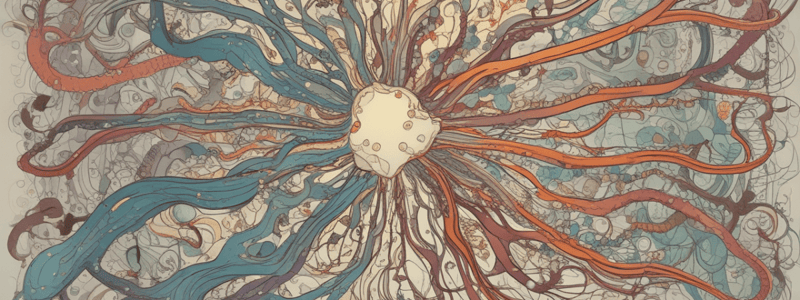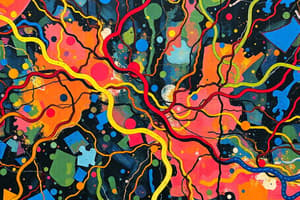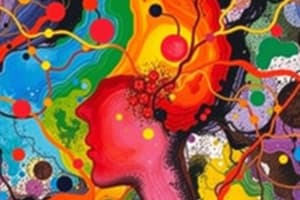Podcast
Questions and Answers
Which dopamine pathway is involved in reward processing, motivation, and emotional responses?
Which dopamine pathway is involved in reward processing, motivation, and emotional responses?
- Mesocortical Pathway
- Nigrostriatal Pathway
- Mesolimbic Pathway (correct)
- Cerebellar Pathway
What is the primary function of the nigrostriatal pathway?
What is the primary function of the nigrostriatal pathway?
- Motor control and coordination (correct)
- Cognitive functions and executive control
- Social behavior and emotional regulation
- Reward processing and emotional responses
Which symptoms of schizophrenia are associated with hyperactivity of the mesolimbic pathway?
Which symptoms of schizophrenia are associated with hyperactivity of the mesolimbic pathway?
- Motor symptoms such as tremors and rigidity
- Positive symptoms such as hallucinations and delusions (correct)
- Negative symptoms such as cognitive deficits
- Cognitive symptoms such as attention deficits
What is the origin of the mesocortical pathway?
What is the origin of the mesocortical pathway?
Which dopamine pathway is involved in cognitive functions, executive control, decision-making, and working memory?
Which dopamine pathway is involved in cognitive functions, executive control, decision-making, and working memory?
What is the result of reduced dopamine transmission in the prefrontal cortex (PFC)?
What is the result of reduced dopamine transmission in the prefrontal cortex (PFC)?
Which of the following is NOT a region targeted by the mesolimbic pathway?
Which of the following is NOT a region targeted by the mesolimbic pathway?
What is the implication of hypofunction of the mesocortical pathway in schizophrenia?
What is the implication of hypofunction of the mesocortical pathway in schizophrenia?
What is the main function of the tuberoinfundibular pathway?
What is the main function of the tuberoinfundibular pathway?
What is a potential side effect of antipsychotic medications that block dopamine D2 receptors in the tuberoinfundibular pathway?
What is a potential side effect of antipsychotic medications that block dopamine D2 receptors in the tuberoinfundibular pathway?
According to the dopamine hypothesis, what contributes to the characteristic symptoms of schizophrenia?
According to the dopamine hypothesis, what contributes to the characteristic symptoms of schizophrenia?
What is the primary mechanism of action of antipsychotic medications in treating schizophrenia?
What is the primary mechanism of action of antipsychotic medications in treating schizophrenia?
What is a potential side effect of antipsychotic medications that can occur as a result of alterations in the nigrostriatal pathway?
What is a potential side effect of antipsychotic medications that can occur as a result of alterations in the nigrostriatal pathway?
What is the relationship between dopamine and other neurotransmitter systems in schizophrenia?
What is the relationship between dopamine and other neurotransmitter systems in schizophrenia?
What is the consequence of dopamine D2 receptor blockade in the tuberoinfundibular pathway?
What is the consequence of dopamine D2 receptor blockade in the tuberoinfundibular pathway?
Which of the following is a direct consequence of hyperprolactinemia in schizophrenia?
Which of the following is a direct consequence of hyperprolactinemia in schizophrenia?
What is the primary contribution of dopamine transmission imbalance to schizophrenia symptoms?
What is the primary contribution of dopamine transmission imbalance to schizophrenia symptoms?
Which dopamine pathway is indirectly affected by antipsychotic medications?
Which dopamine pathway is indirectly affected by antipsychotic medications?
What is the underlying mechanism of antipsychotic medications in treating schizophrenia?
What is the underlying mechanism of antipsychotic medications in treating schizophrenia?
What is the relationship between dopamine and other neurotransmitter systems in schizophrenia?
What is the relationship between dopamine and other neurotransmitter systems in schizophrenia?
What is the primary region targeted by the mesolimbic pathway that is involved in emotional responses?
What is the primary region targeted by the mesolimbic pathway that is involved in emotional responses?
Which of the following dopamine pathways is NOT involved in motivation?
Which of the following dopamine pathways is NOT involved in motivation?
What is the result of hyperactivity of the mesolimbic pathway in schizophrenia?
What is the result of hyperactivity of the mesolimbic pathway in schizophrenia?
Which dopamine pathway is involved in both cognitive functions and executive control?
Which dopamine pathway is involved in both cognitive functions and executive control?
What is the result of hypofunction of the mesocortical pathway in schizophrenia?
What is the result of hypofunction of the mesocortical pathway in schizophrenia?
Which of the following is NOT a region targeted by the nigrostriatal pathway?
Which of the following is NOT a region targeted by the nigrostriatal pathway?
What is the primary function of the substantia nigra in the nigrostriatal pathway?
What is the primary function of the substantia nigra in the nigrostriatal pathway?
What is the implication of excessive dopamine transmission in the mesolimbic pathway in schizophrenia?
What is the implication of excessive dopamine transmission in the mesolimbic pathway in schizophrenia?
In depression, reduced activity in which brain region is associated with cognitive deficits and impaired emotional regulation?
In depression, reduced activity in which brain region is associated with cognitive deficits and impaired emotional regulation?
What is the primary role of the amygdala in anxiety disorders?
What is the primary role of the amygdala in anxiety disorders?
In schizophrenia, which brain region is implicated in the physiological symptoms of anxiety?
In schizophrenia, which brain region is implicated in the physiological symptoms of anxiety?
What is the effect of reduced neurogenesis in the hippocampus on individuals with depression?
What is the effect of reduced neurogenesis in the hippocampus on individuals with depression?
In anxiety disorders, what is the role of the Anterior Cingulate Cortex (ACC)?
In anxiety disorders, what is the role of the Anterior Cingulate Cortex (ACC)?
What is the brain region involved in depression that is responsible for impaired emotional regulation?
What is the brain region involved in depression that is responsible for impaired emotional regulation?
In schizophrenia, which dopamine pathway is associated with positive symptoms such as hallucinations and delusions?
In schizophrenia, which dopamine pathway is associated with positive symptoms such as hallucinations and delusions?
What is the brain region involved in depression that is responsible for memory deficits and difficulty in forming new memories?
What is the brain region involved in depression that is responsible for memory deficits and difficulty in forming new memories?
Which brain region is involved in decision-making, behavioral flexibility, and response inhibition in Obsessive-Compulsive Disorder?
Which brain region is involved in decision-making, behavioral flexibility, and response inhibition in Obsessive-Compulsive Disorder?
What is the primary consequence of hyperactivity in the Anterior Cingulate Cortex (ACC) in Obsessive-Compulsive Disorder?
What is the primary consequence of hyperactivity in the Anterior Cingulate Cortex (ACC) in Obsessive-Compulsive Disorder?
Which brain region is involved in fear conditioning, emotional memory consolidation, and heightened reactivity to trauma-related cues in Post-Traumatic Stress Disorder?
Which brain region is involved in fear conditioning, emotional memory consolidation, and heightened reactivity to trauma-related cues in Post-Traumatic Stress Disorder?
What is the consequence of reduced activity in the Prefrontal Cortex (PFC) in Post-Traumatic Stress Disorder?
What is the consequence of reduced activity in the Prefrontal Cortex (PFC) in Post-Traumatic Stress Disorder?
Which dopamine pathway is involved in negative symptoms and cognitive deficits in Schizophrenia?
Which dopamine pathway is involved in negative symptoms and cognitive deficits in Schizophrenia?
What is the consequence of structural and functional abnormalities in the Temporal and Frontal Cortex in Schizophrenia?
What is the consequence of structural and functional abnormalities in the Temporal and Frontal Cortex in Schizophrenia?
Which brain region is involved in error detection and cognitive control in Obsessive-Compulsive Disorder?
Which brain region is involved in error detection and cognitive control in Obsessive-Compulsive Disorder?
What is the implication of dysregulation of the Hypothalamic-Pituitary-Adrenal (HPA) Axis in Post-Traumatic Stress Disorder?
What is the implication of dysregulation of the Hypothalamic-Pituitary-Adrenal (HPA) Axis in Post-Traumatic Stress Disorder?
What is the primary difference between Tourette syndrome and persistent tic disorder?
What is the primary difference between Tourette syndrome and persistent tic disorder?
What is the minimum duration of tic symptoms required for a diagnosis of persistent tic disorder?
What is the minimum duration of tic symptoms required for a diagnosis of persistent tic disorder?
What is the key difference between provisional tic disorder and persistent tic disorder?
What is the key difference between provisional tic disorder and persistent tic disorder?
What is the primary goal of clinicians when diagnosing tic disorders?
What is the primary goal of clinicians when diagnosing tic disorders?
What is a common characteristic of both persistent tic disorder and Tourette syndrome?
What is a common characteristic of both persistent tic disorder and Tourette syndrome?
What is not a key difference between Tourette syndrome and persistent tic disorder?
What is not a key difference between Tourette syndrome and persistent tic disorder?
What is the primary characteristic that distinguishes Tourette syndrome from provisional tic disorder?
What is the primary characteristic that distinguishes Tourette syndrome from provisional tic disorder?
Which of the following conditions involves only motor tics or vocal tics, but not both?
Which of the following conditions involves only motor tics or vocal tics, but not both?
What is the age limit for the onset of tics in Tourette syndrome?
What is the age limit for the onset of tics in Tourette syndrome?
Which of the following is NOT a characteristic of motor tics?
Which of the following is NOT a characteristic of motor tics?
What is the primary difference between Tourette syndrome and persistent motor or vocal tic disorder?
What is the primary difference between Tourette syndrome and persistent motor or vocal tic disorder?
What is the minimum duration of tics required for a diagnosis of Tourette syndrome?
What is the minimum duration of tics required for a diagnosis of Tourette syndrome?
Which of the following is a characteristic of vocal tics?
Which of the following is a characteristic of vocal tics?
What is the primary similarity between Tourette syndrome and provisional tic disorder?
What is the primary similarity between Tourette syndrome and provisional tic disorder?
What is the typical EEG activity associated with wakefulness?
What is the typical EEG activity associated with wakefulness?
Which sleep stage is characterized by sleep spindles and K-complexes?
Which sleep stage is characterized by sleep spindles and K-complexes?
What is the primary impact of insomnia on brain waves?
What is the primary impact of insomnia on brain waves?
What is a characteristic EEG finding in narcolepsy?
What is a characteristic EEG finding in narcolepsy?
What is the impact of sleep apnea on normal sleep architecture?
What is the impact of sleep apnea on normal sleep architecture?
What is the function of Stage N3 sleep?
What is the function of Stage N3 sleep?
What is the characteristic EEG pattern of REM sleep?
What is the characteristic EEG pattern of REM sleep?
Which sleep stage is characterized by theta waves and is considered a transition between wakefulness and sleep?
Which sleep stage is characterized by theta waves and is considered a transition between wakefulness and sleep?
Flashcards are hidden until you start studying
Study Notes
Dopamine Pathways in the Brain
- Dopamine is a neurotransmitter crucial for motivation, reward processing, and movement control.
- Abnormalities in dopamine signaling are implicated in the pathophysiology of schizophrenia.
Mesolimbic Pathway
- Projects from the ventral tegmental area (VTA) to the limbic system, including the nucleus accumbens, amygdala, and hippocampus.
- Involved in reward processing, motivation, and emotional responses.
- Hyperactivity in this pathway is associated with positive symptoms of schizophrenia, such as hallucinations and delusions.
- Excessive dopamine transmission in this pathway may contribute to aberrant perceptions and heightened emotional responses in schizophrenia.
Mesocortical Pathway
- Originates from the VTA and projects to the prefrontal cortex (PFC).
- Crucial for cognitive functions, executive control, decision-making, and working memory.
- Hypofunction of this pathway is believed to contribute to negative symptoms of schizophrenia, such as cognitive deficits, social withdrawal, and impaired executive function.
- Reduced dopamine transmission in the PFC can lead to deficits in cognitive processing and goal-directed behavior.
Nigrostriatal Pathway
- Originates from the substantia nigra and projects to the striatum (caudate nucleus and putamen).
- Involved in motor control and coordination.
- Alterations in this pathway can contribute to movement disorders like Parkinsonism, a side effect of antipsychotic medications.
Tuberoinfundibular Pathway
- Extends from the hypothalamus to the pituitary gland.
- Regulates the secretion of hormones, particularly prolactin.
- Hyperprolactinemia (elevated prolactin levels) can occur as a side effect of antipsychotic medications that block dopamine D2 receptors in this pathway.
- This can lead to menstrual irregularities, galactorrhea (inappropriate lactation), and sexual dysfunction in individuals with schizophrenia.
Schizophrenia and Dopamine
- The dopamine hypothesis suggests that an imbalance in dopamine transmission, particularly hyperactivity of mesolimbic pathways and hypoactivity of mesocortical pathways, contributes to characteristic symptoms of schizophrenia.
- Antipsychotic medications primarily work by blocking dopamine D2 receptors, reducing dopamine activity and alleviating positive symptoms like hallucinations and delusions.
Dopamine Pathways in the Brain
- Dopamine is a neurotransmitter crucial for motivation, reward processing, and movement control.
- Abnormalities in dopamine signaling are implicated in the pathophysiology of schizophrenia.
Mesolimbic Pathway
- Projects from the ventral tegmental area (VTA) to the limbic system, including the nucleus accumbens, amygdala, and hippocampus.
- Involved in reward processing, motivation, and emotional responses.
- Hyperactivity in this pathway is associated with positive symptoms of schizophrenia, such as hallucinations and delusions.
- Excessive dopamine transmission in this pathway may contribute to aberrant perceptions and heightened emotional responses in schizophrenia.
Mesocortical Pathway
- Originates from the VTA and projects to the prefrontal cortex (PFC).
- Crucial for cognitive functions, executive control, decision-making, and working memory.
- Hypofunction of this pathway is believed to contribute to negative symptoms of schizophrenia, such as cognitive deficits, social withdrawal, and impaired executive function.
- Reduced dopamine transmission in the PFC can lead to deficits in cognitive processing and goal-directed behavior.
Nigrostriatal Pathway
- Originates from the substantia nigra and projects to the striatum (caudate nucleus and putamen).
- Involved in motor control and coordination.
- Alterations in this pathway can contribute to movement disorders like Parkinsonism, a side effect of antipsychotic medications.
Tuberoinfundibular Pathway
- Extends from the hypothalamus to the pituitary gland.
- Regulates the secretion of hormones, particularly prolactin.
- Hyperprolactinemia (elevated prolactin levels) can occur as a side effect of antipsychotic medications that block dopamine D2 receptors in this pathway.
- This can lead to menstrual irregularities, galactorrhea (inappropriate lactation), and sexual dysfunction in individuals with schizophrenia.
Schizophrenia and Dopamine
- The dopamine hypothesis suggests that an imbalance in dopamine transmission, particularly hyperactivity of mesolimbic pathways and hypoactivity of mesocortical pathways, contributes to characteristic symptoms of schizophrenia.
- Antipsychotic medications primarily work by blocking dopamine D2 receptors, reducing dopamine activity and alleviating positive symptoms like hallucinations and delusions.
Psychological Disorders and Brain Regions
- Depression involves reduced activity in the Prefrontal Cortex (PFC), particularly the dorsolateral prefrontal cortex (DLPFC), leading to cognitive deficits and impaired emotional regulation.
- In depression, the Amygdala shows increased activity, contributing to heightened emotional reactivity.
- Reduced volume and neurogenesis in the Hippocampus are linked to memory deficits and difficulty in forming new memories in individuals with depression.
Anxiety Disorders
- The Amygdala plays a central role in the fear response and anxiety regulation, and hyperactivity is common in anxiety disorders, leading to heightened fear and emotional arousal.
- Dysregulation of the Anterior Cingulate Cortex (ACC) is associated with difficulties in modulating emotional responses and attention biases towards threat stimuli.
- The Hypothalamus is implicated in the physiological symptoms of anxiety disorders, particularly in regulating the autonomic nervous system and the release of stress hormones.
Schizophrenia
- Hyperactivity of the Mesolimbic Pathway, projecting from the ventral tegmental area (VTA) to the limbic system, is associated with positive symptoms such as hallucinations and delusions.
- Hypofunction of the Mesocortical Pathway, projecting from the VTA to the prefrontal cortex (PFC), contributes to negative symptoms and cognitive deficits in schizophrenia.
- Structural and functional abnormalities in the Temporal and Frontal Cortex, including reduced gray matter volume and connectivity disruptions, are observed in individuals with schizophrenia, impacting cognitive processing and social cognition.
Obsessive-Compulsive Disorder (OCD)
- Dysregulation within the Basal Ganglia, particularly the striatum (caudate nucleus and putamen), is implicated in the repetitive behaviors and intrusive thoughts characteristic of OCD.
- Dysfunction in the Orbitofrontal Cortex (OFC) contributes to difficulties in suppressing compulsive behaviors and intrusive thoughts.
- Hyperactivity in the Anterior Cingulate Cortex (ACC) is associated with heightened anxiety and the need for compulsive rituals in individuals with OCD.
Post-Traumatic Stress Disorder (PTSD)
- Hyperactivity of the Amygdala and alterations in Hippocampal function are associated with fear conditioning, emotional memory consolidation, and heightened reactivity to trauma-related cues.
- Reduced activity in the Prefrontal Cortex (PFC), particularly the ventromedial prefrontal cortex (vmPFC), impairs fear extinction and inhibitory control over emotional responses in individuals with PTSD.
- Dysregulation of the Hypothalamic-Pituitary-Adrenal (HPA) Axis, leading to abnormal cortisol levels and stress response, is implicated in the physiological symptoms and hyperarousal seen in PTSD.
Tic Disorders
- Tourette syndrome, provisional tic disorder, and persistent (chronic) motor or vocal tic disorder are conditions within the spectrum of tic disorders.
Tourette Syndrome (TS)
- Defined as a neurodevelopmental disorder characterized by multiple motor tics and at least one vocal tic present for more than one year.
- Motor tics: involuntary movements or gestures, such as eye blinking, head jerking, or facial grimacing.
- Vocal tics: involuntary sounds or utterances, such as throat clearing, grunting, or repeated words.
- Criteria: both motor and vocal tics must be present for at least one year, with onset before age 18.
Provisional Tic Disorder
- Characterized by the presence of motor tics, vocal tics, or both, but for a duration shorter than one year.
- Tics may occur multiple times per day, nearly every day, for at least four weeks but less than one year.
- Duration: tics typically last less than one year and may come and go or change in type or severity over time.
- Criteria: diagnosed when tics have been present for less than one year.
Persistent (Chronic) Motor or Vocal Tic Disorder
- Involves either motor tics or vocal tics (but not both) that have been present for more than one year.
- Tics can occur multiple times per day, nearly every day, and may change in type or severity over time.
- Criteria: requires tics to be present for more than one year, but does not require both motor and vocal tics.
Key Differences
- Duration: Tourette syndrome (more than one year), provisional tic disorder (less than one year), and persistent tic disorder (more than one year).
- Specificity: Tourette syndrome requires both motor and vocal tics, while provisional tic disorder and persistent tic disorder are broader categories.
Normal Sleep Stages
- Wakefulness is characterized by beta waves (13-30 Hz) associated with alertness and active mental engagement.
- Stage N1 is the transition between wakefulness and sleep, characterized by theta waves (4-8 Hz).
- Stage N2 is a light sleep stage characterized by sleep spindles and K-complexes, with theta and some delta waves (0.5-4 Hz).
- Stage N3 (formerly Stage 3) is deep sleep or slow-wave sleep (SWS), characterized by delta waves (0.5-2 Hz), which is important for physical and mental restoration.
- REM sleep is associated with dreaming and characterized by desynchronized low-amplitude mixed-frequency EEG activity similar to wakefulness, including theta and beta waves.
Impact of Sleep-Wake Disorders on Brain Waves
- Insomnia is characterized by increased beta activity during NREM sleep and reduced slow-wave sleep (N3), with altered sleep continuity and frequent awakenings.
- Sleep Apnea disrupts normal sleep architecture, leading to fragmented sleep and increased micro-arousals, affecting the progression through NREM and REM stages and altering the balance of sleep stages.
- Narcolepsy is characterized by excessive daytime sleepiness and abnormalities in REM sleep regulation, with rapid transitions into REM sleep from wakefulness (without preceding NREM stages) and presence of sleep-onset REM periods (SOREMPs).
- Parasomnias, such as sleepwalking, night terrors, and REM sleep behavior disorder, involve abnormal arousal mechanisms during sleep, with EEG patterns reflecting partial arousals or mixed sleep-wake states.
Studying That Suits You
Use AI to generate personalized quizzes and flashcards to suit your learning preferences.




